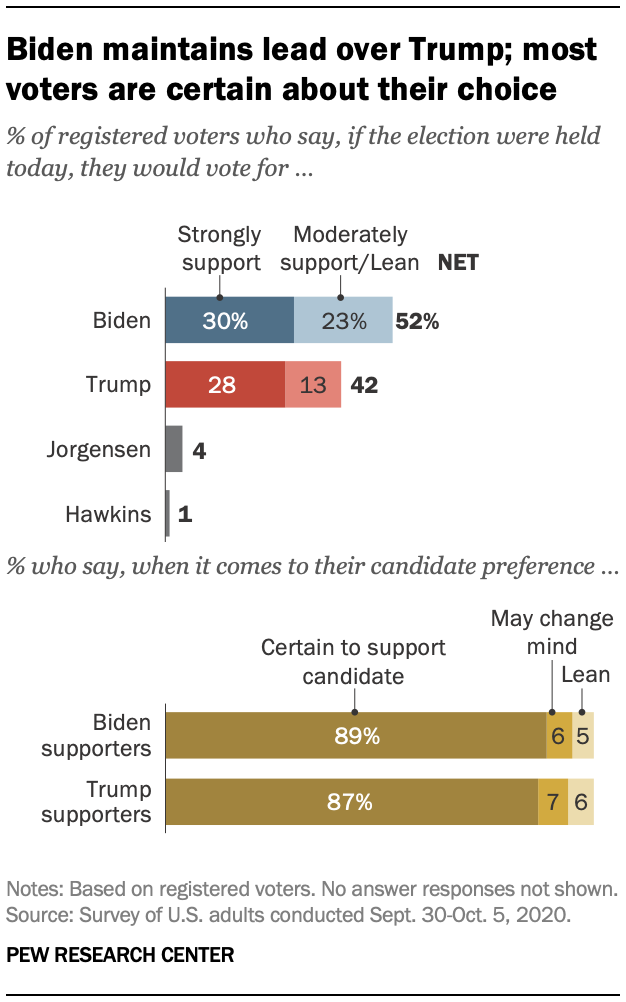 With less than a month until Election Day, Joe Biden maintains his lead over Donald Trump in the presidential race. Today, 52% of registered voters say that if the election were held today, they would cast their vote for Biden; a smaller share of registered voters say they would cast their ballot for Trump (42%). Jo Jorgensen captures 4% of registered voters while Howie Hawkins garners 1% support.
With less than a month until Election Day, Joe Biden maintains his lead over Donald Trump in the presidential race. Today, 52% of registered voters say that if the election were held today, they would cast their vote for Biden; a smaller share of registered voters say they would cast their ballot for Trump (42%). Jo Jorgensen captures 4% of registered voters while Howie Hawkins garners 1% support.
As was the case in 2016 at a similar point in the presidential campaign, voters feel certain about their choices: 89% of Biden voters say they are certain to support their preferred candidate; 87% of Trump voters say the same. Only small shares of either candidate’s supporters say there is a chance they will change their mind (less than 10% of each).
Trump, however, continues to hold an advantage in the share of his voters who say they support him strongly compared with Biden. Today, 68% of Trump voters say they “strongly support” their preferred candidate, compared with 57% of Biden’s voters.
 Biden’s strong support has increased over the past two months: In August, 46% of his voters said they strongly support him. Today, a majority of his voters say this (57%).
Biden’s strong support has increased over the past two months: In August, 46% of his voters said they strongly support him. Today, a majority of his voters say this (57%).
This gap in strength of support mirrors other presidential election years with an incumbent president running for reelection. In 2012, Barack Obama held an advantage over Mitt Romney in strong support; and in 2004, George W. Bush enjoyed more strong support among his voters than John Kerry.
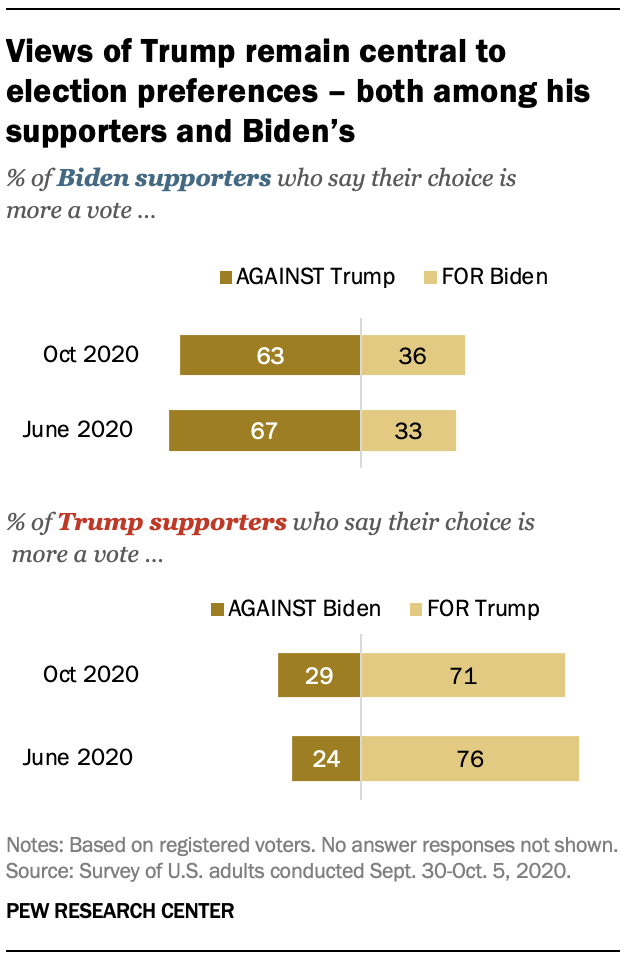 Trump voters remain considerably more likely than Biden voters to say their choice in candidate is more of an expression of support “for” their preferred candidate. In contrast, Biden’s voters are considerably more likely to say their choice is mostly against Trump.
Trump voters remain considerably more likely than Biden voters to say their choice in candidate is more of an expression of support “for” their preferred candidate. In contrast, Biden’s voters are considerably more likely to say their choice is mostly against Trump.
This dynamic is mostly unchanged since earlier this summer, though there has been modest movement among each coalition of voters. Today, Trump’s voters are slightly more likely to say their vote is against Biden (29% today vs. 24% then), while Biden’s voters are slightly less likely to say their choice is more a vote against Trump (67% then vs. 63% today).
As in June 2020, there remain sizable divides among Biden supporters in views of whether they see their vote more as for Biden or against Trump.
Among Biden’s supporters, Black voters and older voters are among the most likely demographic groups to say their choice is for Biden. In contrast, younger Biden supporters and White Biden supporters are far more likely to say their choice is more against Trump.
There is less variation in views among Trump voters, though Trump supporters under 50 years of age are slightly more likely than their older counterparts to say their vote is against Biden rather than for Trump.
Familiar demographic divides in vote preferences
In the final weeks leading up to Election Day, Biden holds a 10 percentage point lead over Trump among registered voters in the presidential race (52% Biden, 42% Trump). Many of the demographic patterns of support for both candidates are similar to those in the 2016 presidential contest.
Just as was the case four years ago, there is a sizable gender gap in candidate preference: Women voters continue to favor the Democratic candidate for president by 17 percentage points (55% to 39%). This is roughly on par with 2016.
In contrast, men are divided. Today, 49% favor Biden while 45% favor Trump. In 2016, men favored Trump by modest margins in preelection polls, as well as among validated 2016 voters.
There are also sizable gaps by race and ethnicity. White voters prefer Trump to Biden (51% vs. 44%, respectively), though Biden is faring slightly better among White voters in the current race relative to Hillary Clinton in 2016.
And the sizable Democratic advantages among Black, Hispanic and Asian American voters are just as large for Biden as they were in 2016. Biden currently leads Black voters by 81 percentage points, Hispanic voters by 34 points and Asian voters by 53 points. Note: Surveys are conducted in English and Spanish.
Younger voters are by far the most supportive of Biden when comparing voter preferences by age: Voters under 30 support Biden over Trump by 30 percentage points (59% vs. 29%, respectively). Voters ages 30 to 49 also prefer Biden to Trump by a 17-point margin. But voters 50 and older are far more divided: 48% say they currently support or lean toward Trump, while a nearly identical share say they support or lean toward Biden (49%). This marks a shift from 2016 – when Trump held a modest lead over Clinton among voters in these age groups.
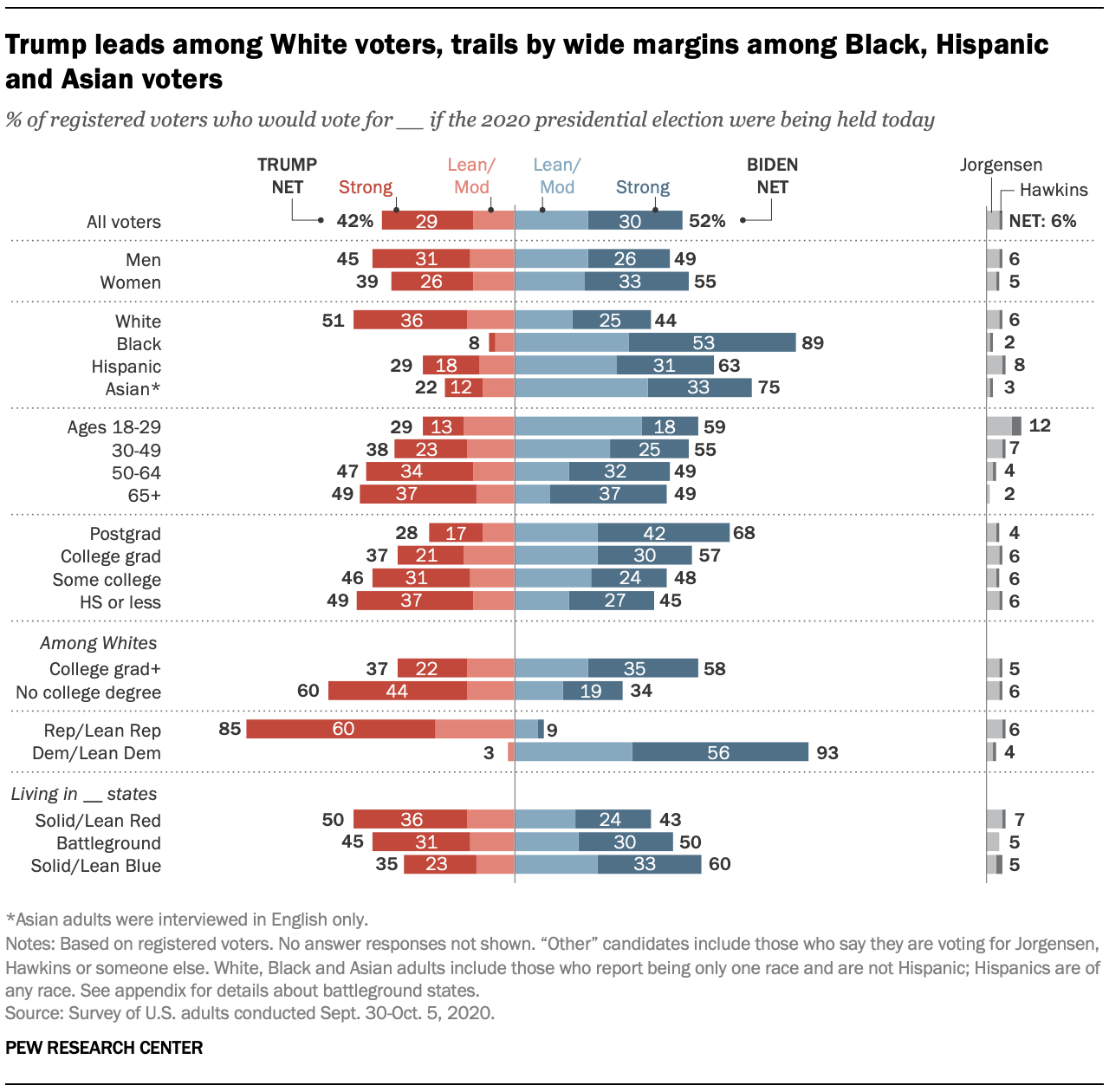
There continue to be large gaps in candidate preference by education. As in 2016, those with a college degree or more are more likely to support the Democratic candidate over Trump. Today, those with no college degree are slightly more divided: 47% say they would vote for Trump if the election were held today, while 46% say they would vote for Biden.
Education is also a dividing line among White voters: College-educated White voters favor Biden by 21 percentage points, while those without a college degree favor Trump by a similar margin.
Republican and Republican-leaning voters are slightly less supportive of their party’s candidate than Democratic and Democratic-leaning voters. Today, 85% of Republican and Republican-leaning independent voters say they would cast a ballot for Trump; 9% say they would support Biden. Among Democratic and Democratic-leaning voters, 93% say they would cast a ballot for Biden if the election were held today; just 3% say they would vote for Trump.
Biden holds a wide lead in states viewed as likely to vote Democrat, or that lean Democratic (“blue” or “lean blue” states) in 2020. In these states, 60% of voters support Biden, while 35% favor Trump. Trump holds a narrow lead, 50% to 43%, in “red” or “red-leaning” states. Across nine states viewed as “battleground” states by election analysts – Arizona, Florida, Georgia, Iowa, Michigan, North Carolina, Ohio, Pennsylvania and Wisconsin – Biden holds a narrow edge (50% vs. 45%). (See Appendix for categorization of states.)
Voter engagement and candidate preferences
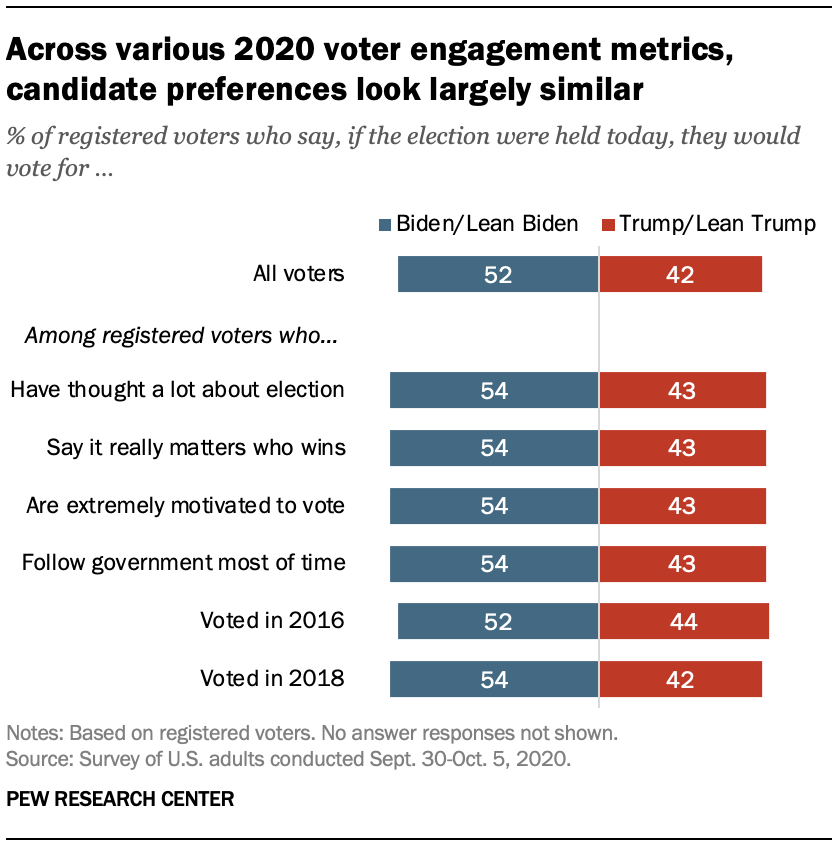 Just as Biden holds an advantage over Trump among all registered voters in the current survey, his lead over Trump looks similar across a variety of voter engagement metrics – ranging from about 8 to 12 percentage points.
Just as Biden holds an advantage over Trump among all registered voters in the current survey, his lead over Trump looks similar across a variety of voter engagement metrics – ranging from about 8 to 12 percentage points.
Biden has a lead among voters who have thought “a lot” about the election (54% vs. 43%, respectively), as well as among those who say “it really matters” who wins the presidential election this November (54% vs. 43%).
The Democratic candidate also leads Trump among those who say they are extremely motivated to vote, and among those who say they follow what is going on in government and public affairs most of the time (54% vs. 43% for each).
And among validated voters – voters whose record of voting in the presidential election were matched to a state-administered voter file – in the two most recent national elections, Biden outperforms Trump among each group: 8 percentage points among 2016 validated voters (52% vs. 44%) and 12 points among 2018 validated voters (54% vs. 42%).
Biden leads among 2016 validated voters
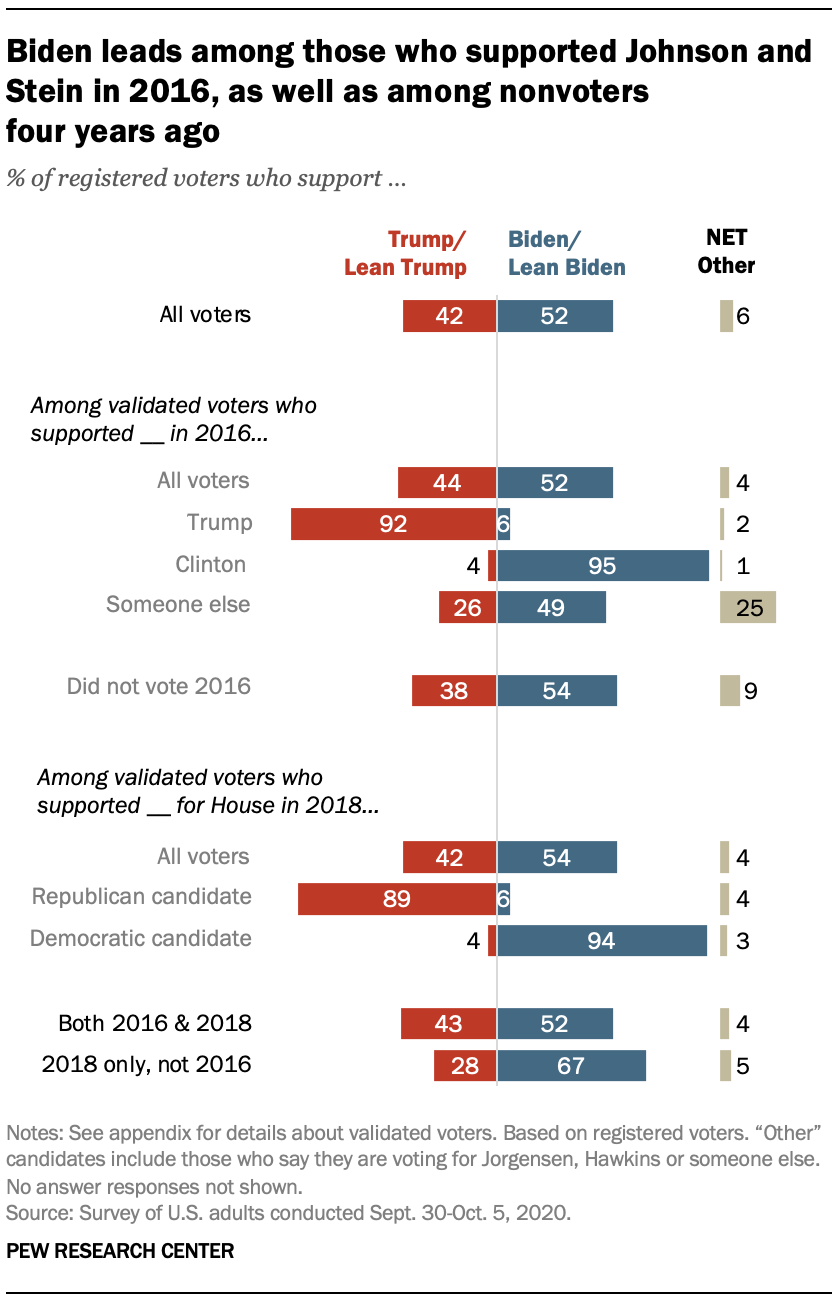 Trump and Biden mostly hold onto their party’s coalition of voters in 2016, though there are some modest differences: About 6% of Trump’s 2016 voters currently say they support or lean toward Biden for president, while 2% say they are supporting a third-party candidate.
Trump and Biden mostly hold onto their party’s coalition of voters in 2016, though there are some modest differences: About 6% of Trump’s 2016 voters currently say they support or lean toward Biden for president, while 2% say they are supporting a third-party candidate.
Similarly, about 4% of validated Clinton voters say they prefer Trump for president this year; 1% say they are supporting a third-party candidate for president.
Biden also holds a modest advantage among those voters who say they supported Gary Johnson, Jill Stein or someone else in 2016: 49% say they lean toward or support Biden, while 26% say they support Trump. A quarter say they plan to vote for a third-party candidate again in 2020. Among those voters who did not vote in 2016, Biden also leads by 16 percentage points (54% vs. 38%).
Among validated 2018 midterm voters – which shifted decidedly toward the Democratic Party compared with 2016 – Biden captures 54% of these voters, while Trump garners 42% support.
Again, Trump and Biden mostly hold onto those voters who cast ballots for their parties’ candidates in the midterm. However, about 10% of verified voters who cast a ballot for a Republican candidate for House in 2018 say they are considering voting for a candidate other than Trump in 2020. In contrast, Biden holds onto 94% of those voters who cast a ballot for a Democratic candidate for House in 2018.
As voters consider how to cast their ballot in the 2020 election this fall, there are sizable gaps in vote preference by method of voting.
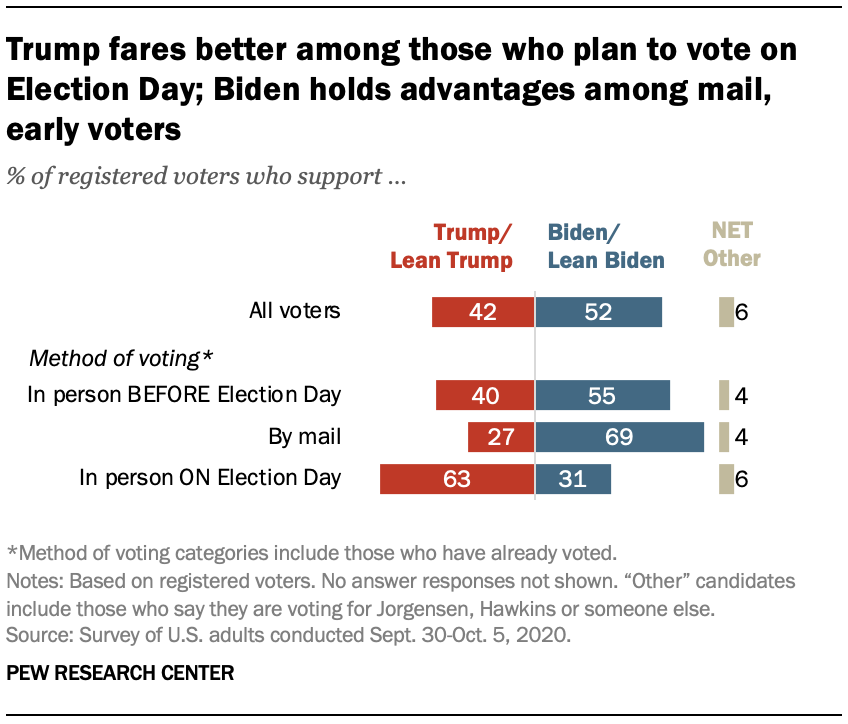 Mirroring divides in preferred method of voting, Biden holds an advantage among registered voters who plan to cast their ballots in person before Election Day: 55% of these voters say they plan to support Biden or lean toward Biden, compared with 40% of in-person, early voters who plan to cast a ballot for Trump.
Mirroring divides in preferred method of voting, Biden holds an advantage among registered voters who plan to cast their ballots in person before Election Day: 55% of these voters say they plan to support Biden or lean toward Biden, compared with 40% of in-person, early voters who plan to cast a ballot for Trump.
Biden’s advantage among absentee or mail voters is even larger: 69% of these voters say they plan to cast a ballot – or have already cast their ballot – for Biden. Only about a quarter say they plan to vote for Trump (27%).
However, Trump captures a sizable majority of those who plan to vote in person on Election Day; 63% of these voters favor Trump, compared with three-in-ten who plan to vote for Biden.
Third-party supporters less motivated to vote than Biden, Trump voters
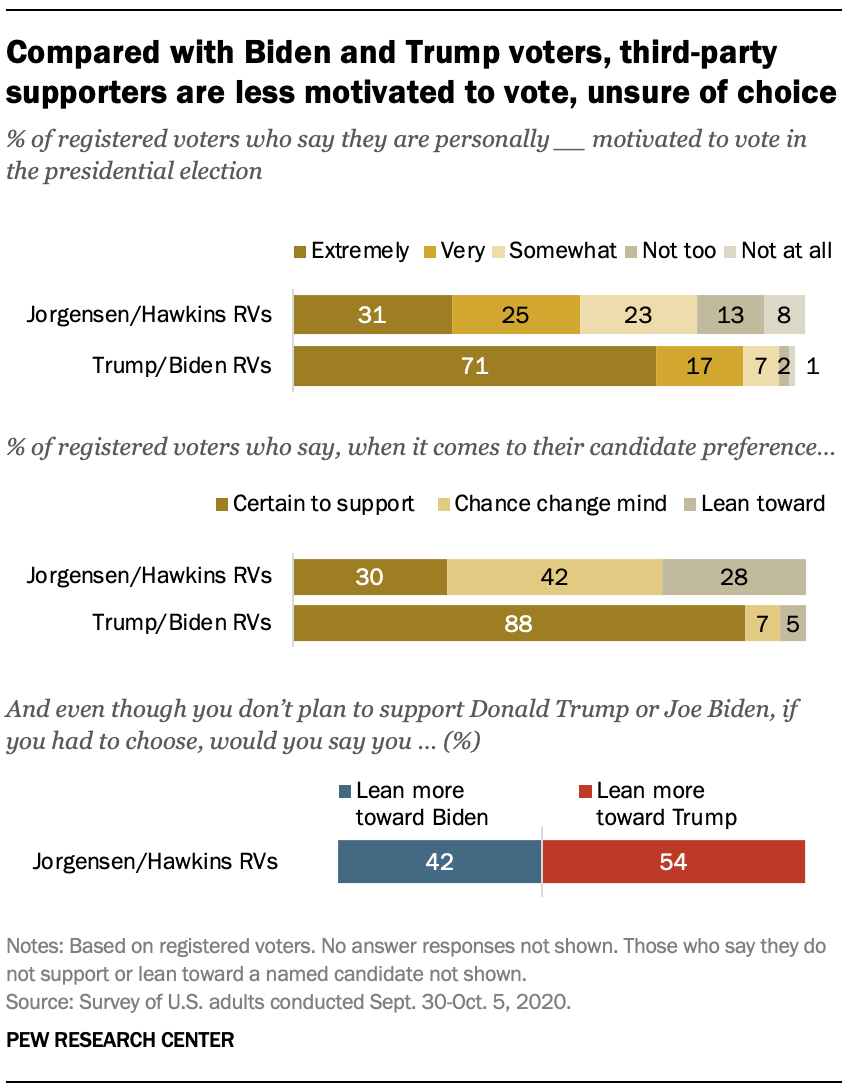 Third party candidates garner 5% support among registered voters – 4% say they support or lean toward Libertarian candidate Jo Jorgensen for president while 1% say they plan to support Green Party candidate Howie Hawkins. Additionally, 1% of voters say they do not plan to vote for any of the four candidates asked about on the survey.
Third party candidates garner 5% support among registered voters – 4% say they support or lean toward Libertarian candidate Jo Jorgensen for president while 1% say they plan to support Green Party candidate Howie Hawkins. Additionally, 1% of voters say they do not plan to vote for any of the four candidates asked about on the survey.
At a similar stage in the presidential cycle in 2016, 14% of registered voters said they planned to vote for a third-party candidate – almost three times as high as the share of registered voters who now say they support a third-party candidate.
Compared with supporters of either of the two major party’s candidates, third-party voters are far less motivated to vote: 31% of Jorgensen and Hawkins voters say they are extremely motivated to vote compared with 71% of Trump and Biden voters.
Third-party supporters are also far less certain about their choice in vote: Three-in-ten Jorgensen and Hawkins supporters say they’re certain to vote for their preferred candidate, while 42% say there is a chance they might change their mind and about three-in-ten (28%) say they lean toward their choice. An overwhelming majority of Trump and Biden supporters (88%) say they are certain to vote for their preferred candidate.
When asked who they would support if they had to choose between Biden and Trump, Jorgensen and Hawkins voters are roughly split: 54% say they would lean toward Trump, while 42% say they would lean toward Biden. In 2016, third-party voters were also split in their choice between Clinton and Trump.


